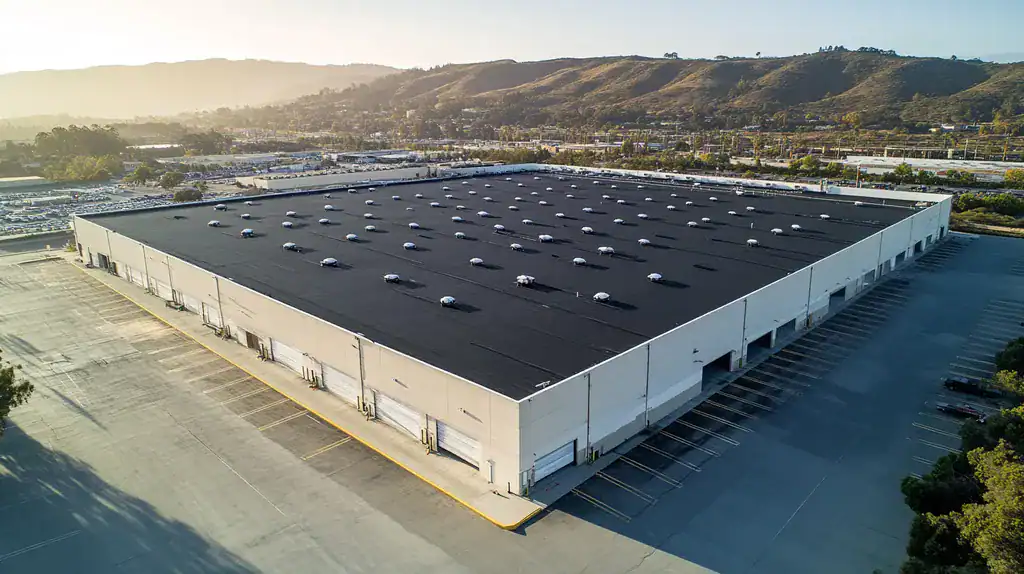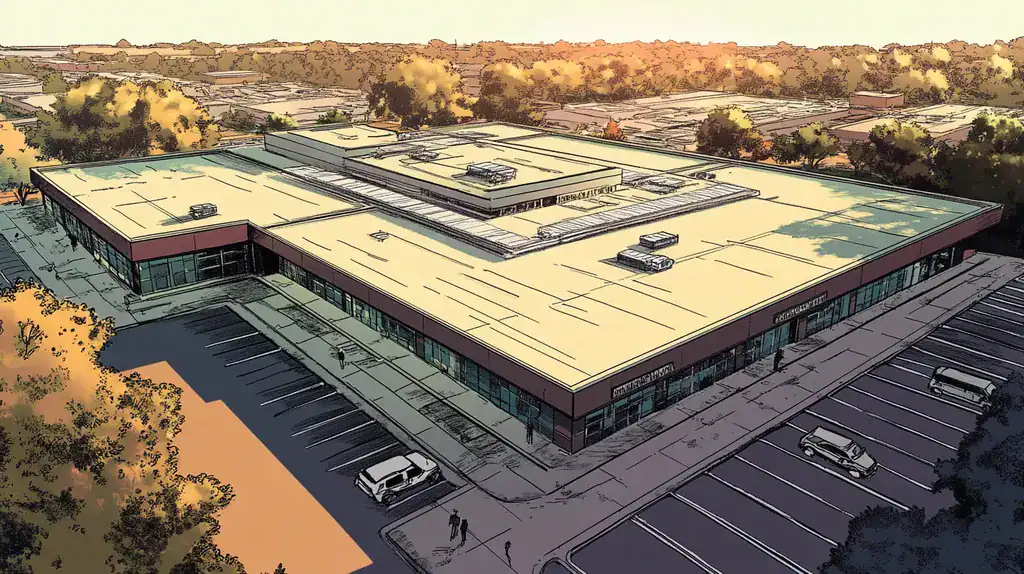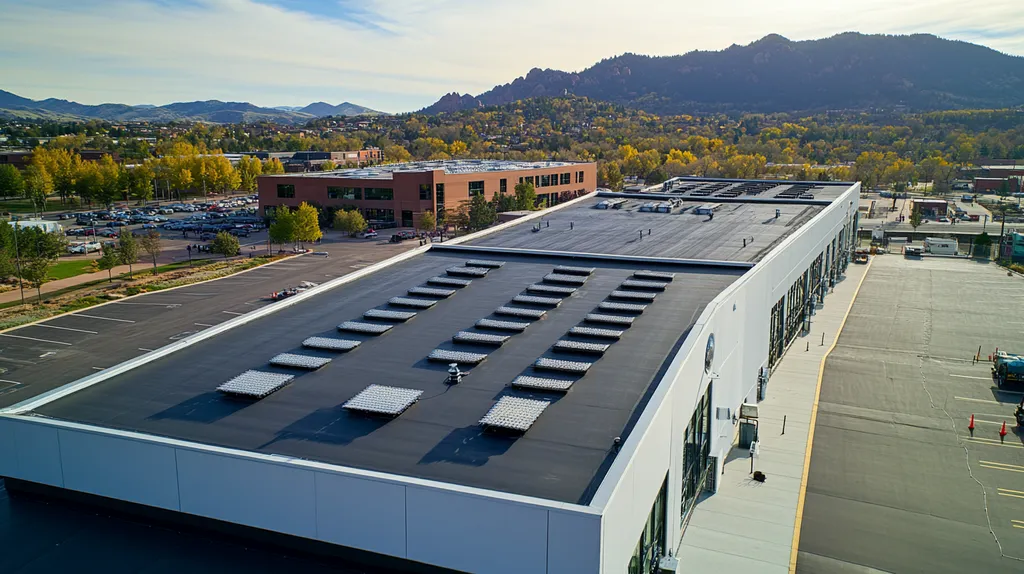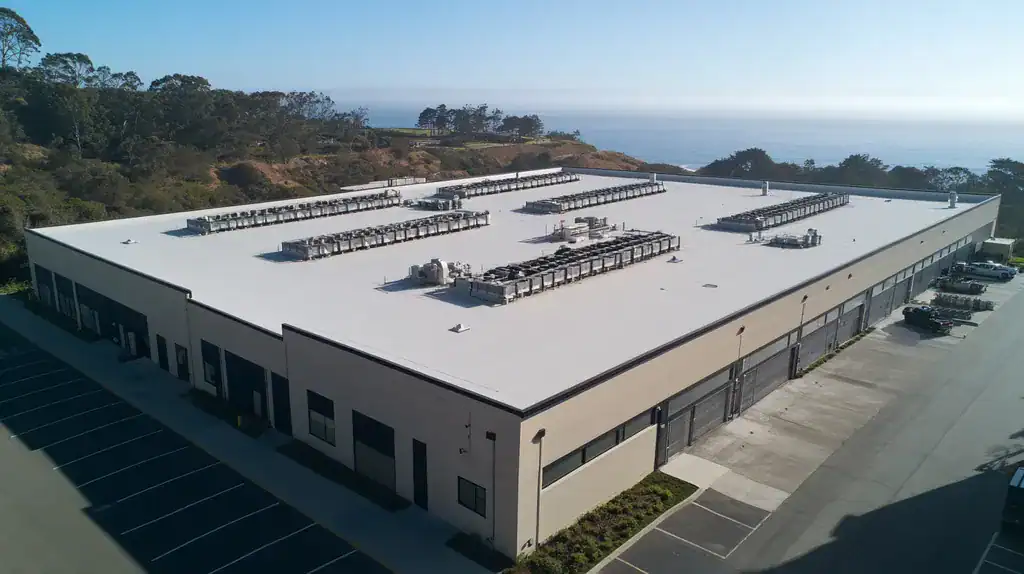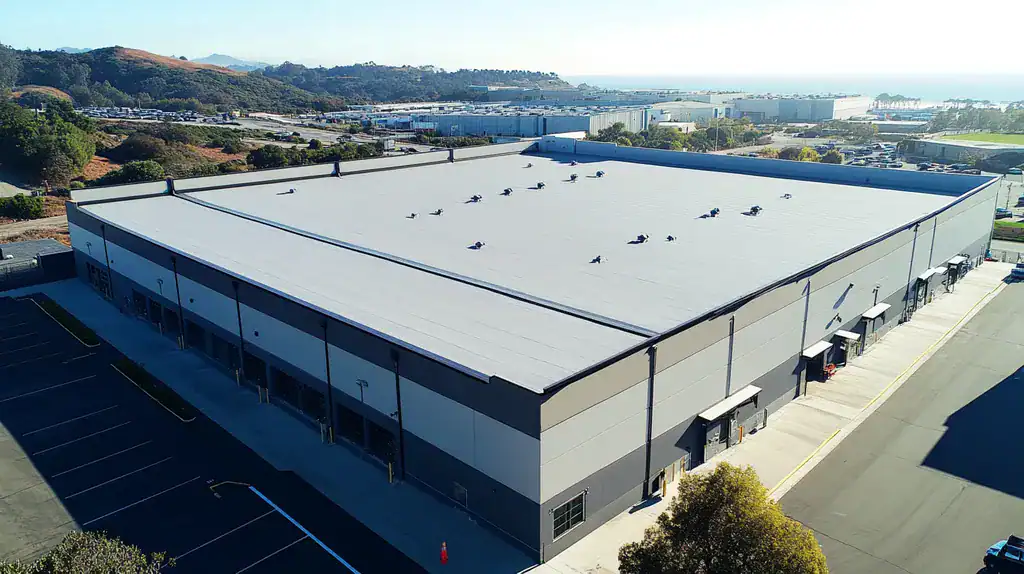Welcome to today’s Battle Royale featuring two roofing heavyweights: “Reflective Roof Coatings” in the east corner versus “Cool Roof Membranes” in the west!
Tonight’s showdown pits these contenders against each other across six punishing rounds designed to test every aspect of their performance for Energy Savings.
At stake? Millions in potential costs, decades of building protection, and the critical performance demands of modern commercial and industrial facilities.
Our professional judging panel will evaluate each round on technical merit, real-world performance, and value delivery. After all six rounds, we’ll declare our ultimate champion.
Ladies and gentlemen, facility managers and building owners… it’s time to rumble!
ROUND 1: INITIAL COSTS & INSTALLATION
In the high-stakes world of commercial roofing, choosing between reflective coatings and cool roof membranes isn’t just about picking a winner – it’s about protecting your bottom line. With energy costs skyrocketing faster than a rocket-powered thermometer, this decision can make the difference between a building that hemorrhages money and one that keeps its cool.
Let’s step into the ring and watch these roofing heavyweights duke it out in three crucial rounds: material costs, installation complexity, and project timeline. Who will emerge victorious in this battle of the budget?
Material Expenses
When it comes to upfront costs, reflective coatings float like a butterfly while cool roof membranes sting like a bee in your wallet. Basic reflective coatings typically range from $1 to $2 per square foot, making them an attractive option for budget-conscious facility managers.
Cool roof membranes, while built to last, can command prices between $3 to $6 per square foot. That’s quite a premium for many property owners to swallow, especially when covering extensive square footage.
A recent study by the Journal of Engineering for Sustainable Buildings and Cities found that reflective coatings with high solar reflectance can reduce HVAC energy consumption by up to 23% in warm climates like Phoenix. (source: Journal of Engineering for Sustainable Buildings and Cities)
In this corner of the competition, reflective coatings claim a clear “ADVANTAGE” with their knockout combination of lower initial costs and proven energy savings.
Installation Complexity
Think of reflective coatings as the lightweight champion of installation – quick on their feet and ready to roll. These coatings can often be applied directly over existing roofing systems with minimal prep work, keeping your facility’s downtime in check.
Cool roof membranes, however, are more like heavyweight fighters – they need extensive preparation and sometimes require complete removal of existing roofing materials. This complexity demands specialized crews and equipment, driving up both cost and time investment.
When it comes to ease of application and minimizing disruption to your operations, reflective coatings dance circles around their membrane competitors, earning another clear “ADVANTAGE.”
Project Timeline
Time is money in the commercial world, and project timeline can make or break your roofing investment. Reflective coatings typically sprint through installation, often completing the job in days rather than weeks.
Cool roof membranes, by contrast, move at more of a heavyweight’s pace. Their installation often involves multiple layers, careful seaming, and longer curing times – all of which can stretch your timeline like a rubber band.
For businesses that can’t afford extended downtime or weather exposure, reflective coatings deliver another solid “ADVANTAGE” with their rapid deployment capabilities.
ROUND 1 WINNER: REFLECTIVE ROOF COATINGS
ROUND 2: DURABILITY & LIFESPAN
In this round, our roofing contenders face their toughest opponent yet: Father Time himself. While both solutions promise to keep your building cool, the real test comes when Mother Nature throws everything she’s got at them – from scorching sun to pounding rain, and even the occasional revenge-seeking seagull with impeccable aim.
Let’s see how these roofing champions handle the heavyweight battle against UV rays, thermal shock, and the relentless march of time. Will your roof still be performing its solar-reflecting magic years down the road, or will it tap out early?
Weather Resistance
Reflective coatings enter this match with impressive flexibility, literally. These coatings expand and contract with your roof’s natural movement, preventing cracks and maintaining their protective shield against the elements.
However, like a boxer who’s taken too many hits, reflective coatings can show wear over time. Their reflective properties may diminish without regular maintenance, and they’re particularly vulnerable to standing water and severe hail.
Cool roof membranes counter with heavyweight durability, boasting superior resistance to punctures, tears, and impact damage. Their factory-controlled thickness and welded seams create a fortress-like defense against whatever the sky throws their way.
In this battle against the elements, cool roof membranes claim a clear “ADVANTAGE” with their superior structural integrity and consistent performance.
UV Resistance
Reflective coatings shine bright in their UV-fighting capabilities, literally reflecting harmful rays away from your roof. Their specialized formulations maintain solar reflectance even after years of sun exposure.
But like a fighter who needs regular conditioning, these coatings require periodic reapplication to maintain peak performance. Most manufacturers recommend refresher coats every 5-7 years to keep that UV-blocking punch strong.
Cool roof membranes bring their own UV-resistant technology to the ring, with specially engineered materials that resist degradation. Their factory-manufactured composition maintains consistent performance without the need for reapplication.
When it comes to long-term UV protection without maintenance requirements, cool roof membranes score another “ADVANTAGE.”
Lifecycle Performance
Reflective coatings deliver impressive performance when properly maintained, often extending an existing roof’s life by 10-15 years. Their ability to self-level and create a seamless barrier makes them particularly effective at preventing leaks.
The maintenance factor can’t be ignored though. While individual repairs are simple, the need for periodic recoating can add up in both cost and labor over time.
Cool roof membranes step into this round with warranties often extending 20-30 years. Their single-piece construction eliminates most maintenance concerns, though repairs when needed can be more complex.
Looking at total lifecycle performance and maintenance requirements, cool roof membranes secure their third “ADVANTAGE” of the round.
ROUND 2 WINNER: Cool Roof Membranes
ROUND 3: PERFORMANCE FACTORS
Ladies and gentlemen, welcome to the main event! In this corner, we have the reigning champion of solar reflection, and in that corner, the undisputed titan of thermal resistance. With energy costs climbing faster than a cat up a hot tin roof, the stakes couldn’t be higher for commercial property owners.
Get ready for three rounds of performance-packed action as these roofing heavyweights battle it out over energy efficiency, thermal performance, and real-world results. Which contender will deliver the knockout punch in energy savings?
Energy Efficiency
When it comes to pure solar reflection, reflective coatings float like a butterfly and sting utility bills like a bee. These coatings create a highly reflective surface that bounces sunlight away before it can transform into heat, dramatically reducing cooling loads.
Cool roof membranes pack their own energy-efficient punch with specialized materials engineered to reflect solar radiation. “A cool roof is designed to reflect more sunlight than a conventional roof, absorbing less solar energy. This lowers the temperature of the building.” (source: U.S. Department of Energy)
In the battle of pure reflectivity and immediate energy impact, reflective coatings claim a clear “ADVANTAGE” with their superior solar reflection properties.
Thermal Performance
Reflective coatings shine brightest in their ability to adapt to temperature fluctuations. Their fluid-applied nature creates a seamless barrier that expands and contracts with the roof, maintaining consistent thermal performance even under extreme conditions.
Cool roof membranes counter with their heavyweight thermal resistance, using multiple layers and advanced materials to create a comprehensive thermal barrier. However, their seams and joints can create potential weak points in thermal performance.
When it comes to maintaining consistent thermal protection across the entire roof surface, reflective coatings score another “ADVANTAGE” with their seamless coverage.
Real-World Results
In the field, reflective coatings demonstrate impressive energy savings right out of the gate. Building owners often report immediate reductions in cooling costs, with some seeing summer energy bills drop by up to 30%.
Cool roof membranes deliver steady, reliable performance over time. Their factory-controlled manufacturing ensures consistent results, though their initial impact on energy bills may not be as dramatic.
For immediate and measurable energy savings that property owners can take to the bank, reflective coatings secure their third “ADVANTAGE” of the round.
ROUND 3 WINNER: REFLECTIVE ROOF COATINGS
ROUND 4: MAINTENANCE REQUIREMENTS
In the high-stakes arena of commercial roofing, maintenance isn’t just about keeping things tidy – it’s about protecting your investment from turning into a money pit. Every speck of dirt, every loose seam, and every missed inspection can chip away at your roof’s energy-saving superpowers faster than kryptonite weakens Superman.
Let’s explore how our contenders handle the daily grind of keeping their energy-saving promises. Will they maintain their reflective prowess through thick and thin, or will time and neglect turn their solar-reflecting capabilities into mere rooftop decorations?
Regular Inspection Requirements
Reflective coatings step into this round with straightforward inspection needs that won’t have your maintenance team pulling their hair out. A simple walk-through every quarter can spot potential issues before they become energy-draining problems.
These coatings mainly need attention to debris removal and surface cleaning to maintain their reflective properties. Most issues can be handled by in-house maintenance crews with basic training and equipment.
Cool roof membranes demand more specialized inspection protocols, often requiring certified professionals to properly assess seams, flashings, and membrane condition. These inspections typically cost more and need to be scheduled well in advance.
For keeping inspection costs and complexity in check, reflective coatings claim a clear “ADVANTAGE” with their user-friendly maintenance requirements.
Cleaning and Repair Procedures
Reflective coatings take the lead again with simple cleaning procedures that often require nothing more than a gentle wash with standard cleaning solutions. Small repairs can usually be handled with basic patching compounds and minimal expertise.
When damage does occur, repairs to reflective coatings typically involve straightforward spot treatments that can be completed quickly and affordably. The seamless nature of these coatings makes repairs blend invisibly with existing surfaces.
Cool roof membranes present more challenges when it comes to cleaning and repairs. Their specialized materials often require specific cleaning agents and repair techniques that must be performed by certified contractors.
In the battle of maintenance simplicity and repair accessibility, reflective coatings score another clear “ADVANTAGE.”
Long-term Maintenance Costs
Reflective coatings shine in the long-term maintenance department by spreading costs out over time through predictable maintenance schedules. Their simple repair procedures and accessible maintenance requirements keep ongoing costs manageable.
Even when recoating becomes necessary, the process remains straightforward and cost-effective compared to major membrane repairs. The ability to maintain these systems without specialized contractors provides significant savings over time.
Cool roof membranes often hit property owners with larger, less predictable maintenance expenses. When repairs are needed, they typically require complete section replacements and specialized installation teams.
For controlling long-term maintenance costs while preserving energy efficiency, reflective coatings secure their third “ADVANTAGE” of the round.
ROUND 4 WINNER: REFLECTIVE ROOF COATINGS
ROUND 5: SUSTAINABILITY CREDENTIALS
In today’s climate-conscious world, a roof’s green credentials pack more punch than a heavyweight champion. With buildings accounting for nearly 40% of global energy consumption, the environmental impact of your roofing choice ripples far beyond your property line.
Let’s see which contender delivers the knockout combination of reduced carbon footprint, material sustainability, and long-term environmental performance. Will your roof help save the planet, or will it become another environmental liability?
Environmental Impact
Reflective coatings enter this round with impressive environmental credentials. Their lightweight nature means less material usage and transportation emissions, while their application process produces minimal waste and volatile organic compounds (VOCs).
These coatings pack a powerful environmental punch by directly combating urban heat islands. Their high solar reflectance can lower local air temperatures and reduce the strain on regional power grids during peak cooling seasons.
Cool roof membranes require more raw materials and energy during manufacturing. While they offer excellent insulation properties, their production process and transportation requirements leave a larger carbon footprint.
For minimizing environmental impact from production to installation, reflective coatings claim a clear “ADVANTAGE.”
Material Sustainability
Reflective coatings shine in the sustainability spotlight with their ability to extend existing roof life. By preserving and enhancing current roofing systems, they significantly reduce landfill waste and the need for new materials.
These coatings can often incorporate recycled content and bio-based materials, further reducing their environmental impact. Their simple composition makes them easier to recycle or responsibly dispose of at the end of their service life.
Cool roof membranes typically contain more synthetic materials and chemical compounds. While many manufacturers are improving their recycling programs, these systems still generate more waste during installation and eventual replacement.
When it comes to material sustainability and waste reduction, reflective coatings secure another “ADVANTAGE.”
Energy Conservation
In the battle for energy efficiency, reflective coatings deliver immediate results by dramatically reducing solar heat gain. Their seamless application ensures consistent performance across the entire roof surface, maximizing energy savings potential.
The thermal performance of these coatings remains remarkably stable over time, requiring only periodic cleaning to maintain their energy-saving properties. Their ability to reduce peak cooling demands helps facilities decrease their carbon footprint year after year.
Cool roof membranes offer strong thermal resistance but may experience performance variations at seams and joints. While they provide excellent insulation, their energy-saving potential can be compromised by installation quality and aging.
For consistent, long-term energy conservation benefits, reflective coatings earn their third “ADVANTAGE” of the round.
ROUND 5 WINNER: Reflective Roof Coatings
ROUND 6: SPECIALIZED APPLICATIONS
When it comes to specialized roofing applications, choosing the wrong solution is like bringing a knife to a gunfight – you’re going to lose, and it’s going to be expensive. With commercial buildings facing increasingly extreme weather patterns and skyrocketing energy costs, the stakes have never been higher.
Let’s explore how our contenders perform in three critical specialized scenarios: scorching desert conditions, dense urban environments, and demanding industrial settings. Which solution will prove itself the heavyweight champion of specialized applications?
Hot Climate Performance
In regions where the sun feels like it’s conducting a personal vendetta against your energy bill, roof performance can make or break your bottom line. These punishing environments demand solutions that can take the heat without tapping out.
Reflective coatings enter this round with impressive heat-fighting credentials. Their seamless application creates an unbroken defensive line against solar radiation, while their self-leveling properties ensure consistent coverage even on complex roof geometries.
Cool roof membranes bring their own heat-fighting capabilities but often struggle with seam integrity under extreme thermal cycling. Their rigid structure can lead to warping and separation in the most punishing conditions.
For maintaining performance under brutal sun exposure, reflective coatings claim a clear “ADVANTAGE” with their superior heat resistance and adaptability.
Urban Applications
City rooftops face unique challenges, from air pollution to restricted access for maintenance crews. The urban environment demands solutions that can handle these specialized conditions while still delivering energy savings.
Reflective coatings shine in urban settings with their ability to be applied and maintained in tight spaces. Their resistance to air pollutants and ability to self-clean with rainfall helps maintain performance even in the dirtiest city environments.
Cool roof membranes struggle with urban challenges, particularly around rooftop equipment and complex penetrations. Their rigid structure makes it difficult to achieve proper sealing around the numerous obstacles typical of city rooftops.
When it comes to urban-specific challenges and maintenance accessibility, reflective coatings secure another “ADVANTAGE.”
Industrial Facilities
Industrial buildings throw down the gauntlet with their unique combination of high heat loads, chemical exposures, and frequent maintenance traffic. These facilities need roofing solutions that can handle punishment while keeping energy costs in check.
Reflective coatings adapt well to industrial environments, offering excellent chemical resistance and easy repairs when needed. Their flexibility allows them to handle vibration from equipment without cracking or separating.
Cool roof membranes bring durability to the fight but often struggle with point loads from maintenance traffic and equipment installation. Their seams can become vulnerable points for chemical infiltration and degradation.
For managing industrial-specific challenges while maintaining energy efficiency, reflective coatings earn their third “ADVANTAGE” of the round.
ROUND 6 WINNER: REFLECTIVE ROOF COATINGS
AND THE WINNER IS…
Ladies and gentlemen, after six punishing rounds of technical evaluation, we have our verdict!
With a dominant performance winning FIVE out of SIX rounds, our new Energy Savings Champion is… REFLECTIVE ROOF COATINGS!
This lightweight contender proved its worth by delivering knockout combinations of lower initial costs, simpler maintenance requirements, and superior sustainability credentials. Its particular strengths in specialized applications and consistent energy performance helped secure this decisive victory.
But don’t count Cool Roof Membranes out completely! This heavyweight champion still rules supreme when maximum durability and minimal long-term maintenance are the top priorities, as we saw in Round 2. For buildings facing extreme weather conditions or requiring 20+ year lifespans, Cool Roof Membranes remain a formidable contender.
IMPORTANT NOTICE: While this analysis reflects general performance characteristics, every building presents unique challenges. Local climate conditions, existing roof structures, and specific facility requirements can all impact performance. Property owners should consult qualified roofing professionals who can evaluate their particular situation before making a final decision.
Remember, champions aren’t crowned by following the crowd – they’re made by matching the right roofing solution to their specific building’s needs. Now get out there and make your energy-saving dreams a reality!
FREQUENTLY ASKED QUESTIONS
Q. What are the initial costs of a commercial roof coating?
A. Reflective coatings typically cost between $1 to $2 per square foot, making them budget-friendly. In contrast, cool roof membranes can range from $3 to $6, often leading to higher upfront expenses for commercial property owners.
Q. How do reflective coatings compare with cool membranes in durability for industrial roofs?
A. Reflective coatings are flexible and can endure some movement, which helps prevent cracking. However, cool roof membranes offer superior resistance to punctures and are more robust against extreme weather conditions, making them last longer under tough conditions.
Q. Which roofing option provides better energy efficiency for a commercial roof?
A. Reflective coatings excel in energy efficiency due to their high solar reflectivity, which significantly lowers cooling costs. Cool roof membranes also reflect sunlight but may not provide the same immediate impact on energy expenses.
Q. What are the maintenance requirements for reflective coatings on commercial roofs?
A. Reflective coatings require simple maintenance, mainly involving periodic inspections and debris removal. Their straightforward repair process allows for quick fixes that can be handled by in-house teams, keeping costs manageable over time.
Q. Are reflective roof coatings environmentally friendly for commercial buildings?
A. Yes! Reflective coatings are environmentally friendly, using less material and generating less waste during installation. Their ability to lower air temperatures helps combat urban heat islands, making them a green choice for energy-conscious property owners.
Q. How do reflective coatings perform in specialized applications for industrial roofs?
A. Reflective coatings perform exceptionally well in specialized applications, offering excellent heat resistance and adaptability to various conditions. They’re particularly effective in industrial settings where chemical exposure and high traffic are common.
Q. Can reflective coatings be applied over existing roofing systems on commercial roofs?
A. Absolutely! Reflective coatings can be directly applied over existing commercial roofing systems with minimal preparation. This versatility helps reduce downtime during installation, making it easier for facilities to maintain their operations.

